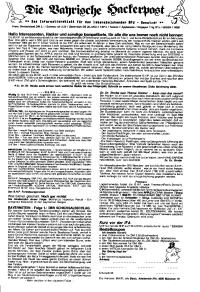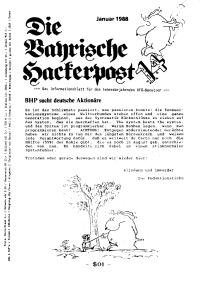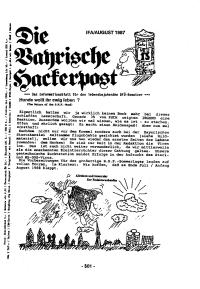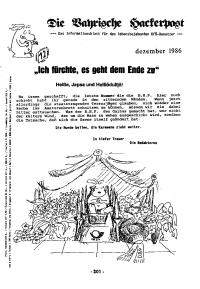Copy Link
Add to Bookmark
Report
HOMEBREW Digest #2897

HOMEBREW Digest #2897 Thu 10 December 1998
FORUM ON BEER, HOMEBREWING, AND RELATED ISSUES
Digest Janitor: janitor@hbd.org
Many thanks to the Observer & Eccentric Newspapers of
Livonia, Michigan for sponsoring the Homebrew Digest.
URL: http://www.oeonline.com
Contents:
GOTT Cooler Source ("RANDY ERICKSON")
Dixie Brewery Review pt. 1 (Jeff Renner)
Dixie Brewery Review pt. 2 (Jeff Renner)
Munich Helles (Thomas S Barnett)
Liquid Smoke. . .at bottling? (Davemundo)
re: re:cap on foam/headspace and 1338 recipe (Jim English)
TV Beer - Sports Center (David)" <drussel3@ford.com>
More Pronunciation - Zum Uerige ("Poirier, Bob")
Peach State Brew-Off; 01/23/1998 (DENNIS WALTMAN)
Drying Iodophor (Nathan Kanous)
Re: Grain Mill ("Charles T. Major")
Re: protein rest now dead (ThE GrEaT BrEwHoLiO)
Books Under the Xmas Tree ("Chuck Bernard")
Grain mill (Lee Menegoni)
bottling / protein rests (Jim Layton)
RE: temperature controller (LaBorde, Ronald)
Re: Beer Books (Matthew Arnold)
LD Carlson Fruit Flavoring ("Jeffrey A. F. Hittinger")
Gott for partial-mash? ("FLAHIE, PATRICK")
Conical Fermenter ("Fortes, Jim R")
reply to: Grain Mill (HBD#2896) (Herbert Bresler)
Re: Copper Salts (John Palmer)
Re: cap on foam / headspace (Eric Reimer)
richards scotts book query (JPullum127)
Keeping the Air Out (Ian Forbes)
No Sparge Efficiency ("Penn, John")
Diffusion Confusion ("Poirier, Bob")
Fries (Al Korzonas)
Son of Palexperiment (Kyle_Druey)
Beer is our obsession and we're late for therapy!
//////
(This space free to a good competition)
//////
NOTE NEW HOMEBREW ADDRESS: hbd.org
Send articles for __publication_only__ to post@hbd.org
If your e-mail account is being deleted, please unsubscribe first!!
To SUBSCRIBE or UNSUBSCRIBE send an e-mail message with the word
"subscribe" or "unsubscribe" to request@hbd.org.
**SUBSCRIBE AND UNSUBSCRIBE REQUESTS MUST BE SENT FROM THE E-MAIL
ACCOUNT YOU WISH TO HAVE SUBSCRIBED OR UNSUBSCRIBED!!!**
IF YOU HAVE SPAM-PROOFED your e-mail address, the autoresponder and
the SUBSCRIBE/UNSUBSCRIBE commands will fail!
Contact brewery@hbd.org for information regarding the "Cat's Meow"
Back issues are available via:
HTML from...
http://hbd.org
Anonymous ftp from...
ftp://hbd.org/pub/hbd/digests
ftp://ftp.stanford.edu/pub/clubs/homebrew/beer
AFS users can find it under...
/afs/ir.stanford.edu/ftp/pub/clubs/homebrew/beer
COPYRIGHT for the Digest as a collection is currently held by hbd.org
(Pat Babcock and Karl Lutzen). Digests in their entirity CANNOT be
reprinted/reproduced without this entire header section unless
EXPRESS written permission has been obtained from hbd.org.
COPYRIGHT for individual posts within each Digest is held by the
author. Articles cannot be extracted from the Digest and
reprinted/reproduced without the EXPRESS written permission of the
author. The author and HBD must be attributed as author and source
in any such reprint/reproduction. (Note: QUOTING of items
originally appearing in the Digest in a subsequent Digest is
exempt from the above.)
JANITORS on duty: Pat Babcock and Karl Lutzen (janitor@hbd.org)
----------------------------------------------------------------------
Date: Tue, 8 Dec 1998 12:55:02 -0800
From: "RANDY ERICKSON" <RANDYE@mid.org>
Subject: GOTT Cooler Source
I just received some tubing and quick disconnects for my RIMS
that I ordered from Moving Brews. The package included some
promotional material that indicated that they now carry the GOTT
insulated coolers in both the 5 gallon and 10 gallon sizes.
The literature did not include the prices, but you can contact
pumps@movingbrews.com or (301) 779-8609 for more info.
I am not affiliated with this company, except as a satisfied
customer.
Cheers,
Randy in Modesto
------------------------------
Date: Tue, 8 Dec 1998 21:44:05 -0500
From: Jeff Renner <nerenner@umich.edu>
Subject: Dixie Brewery Review pt. 1
In October, my wife and I visited Dixie Brewery. While they don't normally
do tours, I had an introduction, and brewmaster Kevin Stuart was incredibly
generous with his time - an hour and a half! Even my long suffering,
non-beer drinking wife Nancy seemed to enjoy it. I reported on it in brief
here, and promised a longer review.
Since then, in a dark corner of my hard drive, I found an old review of
Dixie from Roger Deschner, who posted it on a private brewing mail
listserve. I've printed it below with his permission, since it's better
than anything I could have written. At the end is an amusing brief note
about Dixie HBDer and New Orleans resident Mike Vachow sent me (reprinted
with his permission). Be sure to read it, too.
Kevin sent me home with several unpasteurized bottles and some pasteurized
ones, too. Two other Ann Arbor Brewers' Guild BJCP judges and I did a
blind triangular taste test of these. Three glasses were poured, two were
either pasteurized or not and the other was the different one. This is a
tough test that commercial brewries use for wuality control. The taster
must be able to tell which is the odd beer of the three. I was very
pleased to not only tell which was subtly the different one, but to
identify it as the pasteurized one. The unpasteurized ones had "brighter"
hops high notes and clearer malt expression. The pasteurized one was a
nice beer, but just not as special. Unfortunately, when I finished, I
asked my daughter, who was steward, for the key to my glasses, and she
revealed all three keys, before the other two judges had concluded.
I hope you'll all taste this classic on draft (unpasteurized) if you ever
get to New Orleans. While I don't think it's wuite a CAP, it's certainly a
treasure.
Jeff
-=-=-=-=-=-
Date: Sat, 15 Jun 1996 14:26:47 CDT
From: Roger Deschner <U52983@UICVM.UIC.EDU>
Subject: Dixie Brewery Tour Report (long)
Tour report - Dixie Brewery, New Orleans
Roger Deschner, 6/7/96
Now HERE is a working museum piece! The Dixie Brewery is truly one of
the most amazing, miraculous, sights in the brewing world. It was built
in 1907, and is still owned by the same family. Everything here is old
and decrepit. Motors turn on and off, valves hiss, and there is the aroma
of ammonia all over the place. Only a few of the lights work. And
somehow, beer is brewed.
A group of about six of us took the afternoon off from sessions at
the American Homebrewer's Association Conference. Our tour guide was
Kevin Stuart, the head brewer. Kevin was educated at UC Davis, and has
been brewmaster at Dixie for ten years. he says that, despite the hard
work involved in making beer at Dixie, the place gets under your skin.
Maximum capacity in the 1960's was 300,000 barrels/year, but now they
produce only a fraction of that. As a result of the lower production
levels, some parts of the plant are simply closed off, such as a relatively
new fully jacketed set of ageing vessels.
Brewing is done in a relatively new (but still old) stainless mash tun and
brew kettle, which were hauled in from the old Jax brewery when it was
closed. Their original copper brew kettle is no longer used, but they had
polished it nicely to show off to the homebrewers. Grain mills,
wort chillers, etc. all appear to be in pretty good working
condition, although everything is very inconveniently located, involving
lots of stair climbing. The brewers are in tremendous physical condition as
a result. Brewing Blackened Voodoo presents a problem, because the
place was built to make adjunct beers, and they have trouble handling
the volume of barley malt required for an all-malt beer.
All beers are made with "Dixie Super Yeast", a strain which they have been
using continuously for 20 years. They just keep repitching it. They do wash
it, and periodically send a sample off to a lab for analysis, but they
continue to reuse the same yeast, over and over. The local homebrewers have
used it to brew lagers, with good success. The origins of this durable
strain are a company secret. Just another part of the mystique.
Primary fermentation is in relatively new stainless tanks, in an
addition to the building that lost much of its insulation during a
recent hurricane. A door which the storm had pried off its hinges was left
there to rust, bent and twisted, and the open doorway was simply boarded
up. Before that addition was built, primary fermentation was done in
open cypress vats. The gems here are the lagering tanks, which are
made entirely of Louisiana swamp cypress wood. These original beauties
are lovingly tended, and require quite a bit of maintenance. They
are presently experimenting with a new type of wood treatment which
may greatly increase the time between required periodic retreatments.
There is only one other set of wooden beer vessels still in use in the
U.S. (Where? Dubuque? Yeungling?) The lagering cellars, in the middle of
the brewery, are constantly damp and dripping, like a cave, with
the pervasive aroma of ammonia. A fitting place for a beer called
Blackened Voodoo to be made!
-=-=-=-=-
Jeff Renner in Ann Arbor, Michigan c/o nerenner@umich.edu
"One never knows, do one?" Fats Waller, American Musician, 1904-1943.
------------------------------
Date: Tue, 8 Dec 1998 21:45:05 -0500
From: Jeff Renner <nerenner@umich.edu>
Subject: Dixie Brewery Review pt. 2
We climbed up to the roof of the five-story building, for a nice
cool breeze, and to inspect the rice silos up there which have been painted
to look like cans of Dixie beer. The view of Downtown, the
Mississippi River, and the abandoned neighboring Falstaff brewery, with
King Gambrinus still perched on a high balcony, is impressive.
(Kevin confessed to a desire to "borrow" the King and move him over to
Dixie's roof.) One does wonder, though, after climbing the wobbly ladders
and such to get up there, if the whole pile of loose bricks and rusting
pipes might someday simply fall down. The real miracle is that they make
good, uninfected beer in this chaotic mess.
Things look worse than they really are. You see a totally rusted-out
pipe or piece of equipment, but then you realize that they don't use that
one anymore; the one that they do use is in pretty good shape. Since there
is no shortage of floor space inside the convoluted, hulking building,
there is no incentive to haul out the old nonworking stuff. It's easier,
and cheaper, to simply leave it. Two members of our group got lost, and
it took a while for them to find their way out. It's somewhat reminiscent
of Europe, where something called "new" is actually quite old, and the
"old" one is really ancient.
Back down the wobbly ladders, and another trip across the Larry
Bell Memorial Trick Board (I think Larry still has the bruise), and past
the elegant wrought iron front gate, brought us back into the very
plain tasting room for The Reward At The End Of The Brewery Tour. The bar
was made from one of the old cypress tanks. The regular Dixie Beer,
fresh from the brewery tap, is a very pleasant example of a Classic
American Pilsner - a style that starts to look better and better as the
major breweries lighten up their "regular" beers. Dixie is made with
rice adjunct, all grown in Louisiana of course. Blackened Voodoo is
an all-malt beer, medium brown in color, with a pleasant, dry toastiness.
We did not try the new Crimson Voodoo. But we did taste the new
White Chocolate Moose, which is sticky sweet. It is called a "dessert
beer". (I have a feeling this experiment will languish for lack of a
niche.) But we all had to shake our heads in amazement that such pleasant,
clean beers could come out of the rusting jumble we had just toured. That
is, as much as anything, a compliment to the skill and the really hard work
of the brewers.
We also toured the Acadian Brewery, a brand-new micro that has been brewing
for only six months. It's shiny, compact, all-new equipment was in stark
contrast to Dixie. Their best beer is a nice, aromatic, Pilsner.
My Scale for the financial health of a brewery is the condition of
the tuckpointing of its brickwork. Dixie's tuckpointing is bad - all
the bricks are loose. There are lots of broken windows. In fact,
everything here is rusting and falling apart. Dixie was on the verge of
declaring bankruptcy when Blackened Voodoo Beer was banned by the State of
Texas due to its satanic label. The preposterousness of this action
generated so much publicity for Dixie that it literally saved the company
and the brewery. Within days, they couldn't make enough Blackened Voodoo to
meet the demand. The Louisiana Legislature threatened to ban Lone Star Beer
in retaliation, so finally Texas backed down. Since then, Blackened
Voodoo has been very popular in the Lone Star State, and elsewhere.
The brewery, despite its high maintenance and labor costs, is at
least marginally profitable. We had to ponder, how long can they keep going
on like this? Probably forever. The plant, rust, loose bricks and all,
is fully paid for. The tax assessor can't be very hard on such a
decaying relic. The portion of the equipment that is used presently for
production works well enough. So the higher maintenance and labor costs are
offset by lower capital costs. (In contrast, Acadian forks a large part of
their income over to the bank, but has lower operating costs.) As long as
they continue to produce clean beer, and occasionally innovate with
things like Crimson Voodoo, this creaking, hissing, rusting relic can
probably remain viable in the long term.
At any rate, this incredible tour certainly gives me a
different perspective, when I come across a six-pack of a Dixie product in
a store. Despite thoughts of all those rusting pipes and crumbling bricks,
I'll be more likely to buy it (if it's fresh), since it's good, clean,
reasonably interesting beer, and I'll be supporting a real working museum
of brewing history.
Roger Deschner University of Illinois at Chicago rogerd@uic.edu
Aliases: u52983@uicvm.uic.edu R.Deschner@uic.edu USUICZ3P@IBMMAIL
=============== "Civilization was CAUSED by beer." =====================
-=-=-=-=-=-=-
From: Vachom <MVachow@newman.k12.la.us>
To: "'nerenner@umich.edu'" <nerenner@umich.edu>
Subject: Thanks for the report
Date: Fri, 20 Nov 1998 13:22:47 -0600
Jeff:
Thanks for the copy of the report. About midway through reading, it
occurred to me that this description would fit a fair number of New Orleans
institutions. I guess that kind of venerable dilapidation is part of the
city's charm. By my estimation, lots of New Orleanians still drink Dixie,
especially on nights out: crawfish boil party from 8-10, music at Tips from
11-2, nightcap at the Leaf 3-4, breakfast at the Humming bird at 5. . . .
and Dixie every step of the way. If you're drinking Abita's Turbo Dog,
you're liable to wind up face down in the crawfish and miss out on the rest
of the fun. Those foamy bottles of Dixie, on the other hand, suit New
Orleans' brand partying just right. This is undoubtedly the cause of the
same kind of venerable dilapidation among many of the citizens as well.
Happy brewing,
Mike
New Orleans, LA
-=-=-=-=-
Jeff Renner in Ann Arbor, Michigan c/o nerenner@umich.edu
"One never knows, do one?" Fats Waller, American Musician, 1904-1943.
------------------------------
Date: Tue, 8 Dec 1998 20:50:39 -0600 (CST)
From: Thomas S Barnett <barnets@mail.auburn.edu>
Subject: Munich Helles
Hello all,
I recently tried Spaten's Munich Lager and was hoping to create
something along those lines this weekend in an all-grain batch. I've
searched the archives and found few recipes. It's a rather malty beer so i
was thinking a grain bill of 70% pils and 30% munich or vienna. For
hops, perhaps 25-30 IBU with Hallertau or Tettnanger. Any suggestions?
Thanks. Tom Barnett.
------------------------------
Date: Tue, 8 Dec 1998 22:42:11 EST
From: Davemundo@aol.com
Subject: Liquid Smoke. . .at bottling?
I have a recipe calling for adding liquid smoke when bottling.
How should I do this? Just add it (2 tablespoons) to my bottling bucket?
Boil it along with my priming sugar?
Thanks in advance -
Dave
------------------------------
Date: Wed, 09 Dec 1998 07:53:27 -0500
From: Jim English <jimebob@mindspring.com>
Subject: re: re:cap on foam/headspace and 1338 recipe
Towards the end of Brian Dixon's post he mentions using dry
ice as a method to generate CO2 as well as recirculating the
gas generated by the fermentation process itself for those
of us that have not graduated to cylinders...yet!
I have used the gas from primary to flush a secondary carboy
also. Piece of cake, works like a charm. Perhaps inserting
a racking cane into the secondary so the incoming gas starts
at the bottom would speed up the process and ensure that the
air is pushed out sooner?
I have also read, on HBD presumably, about using bread
yeast, warm water and maybe a little sugar as a CO2
generator. I have used this as a method to flush my primary
carboy and to put a blanket over the fruits of my labor
until the wee beasties start doing their thing.
Whatyasay? Any chance of contaminating the brew with the
"wrong" yeast?
Now I want to tap into the collective knowledge base for a
little help.
I have harvested the Wyeast 1338 from the primary from my
attempt at Al's Altbier (which is secondarying( Is THAT
a word?) @ 55F even as we type) and would like to go ahead
and use it again soon. The only recipes I have found that
use this particular strain are Altbier, Kolsh and Berliner
Weisse. I already have 5 gallons of the first and am not
interested in either of the other two types of brew.
Anybody have any creative ideas about using this strain in
some other recipe just for grins?
JRE in Hotlanta
------------------------------
Date: Wed, 09 Dec 1998 08:01:18 -0500
From: "Russell, D. A. (David)" <drussel3@ford.com>
Subject: TV Beer - Sports Center
There was something I noticed on one of my favorite shows last night,
Sports Center, (and you don't even have to be a sports fan to enjoy
it.) It may be a bit off topic but I thought I would share it anyways.
If you have noticed, television has traditionally (or maybe legally),
not shown actual "Commercial" namebrand beers/labels being drunk on a TV
show. They have always been non-descript BEER, etc. Sometimes you can
maybe tell what brand it was, not so cleverly disguised. The episode
last night was based off an impromtu poker game at work (I don't get to
play poker or drink beer at work either). But one thing I noticed,
although the beer bottle labels were only slightly disguised, it was
quite easy to tell what they were. Beers I could see, Bass Ale, Coors,
Amstel, plus a few others. It was refreshing to not see bud/mill
exclusively being drunk.
------------------------------
Date: Wed, 9 Dec 1998 07:48:30 -0600
From: "Poirier, Bob" <Bob_Poirier@adc.com>
Subject: More Pronunciation - Zum Uerige
Greetings!!
I know this whole thread is growing mold, but, I've wondered for a
long time how to correctly pronounce "Zum Uerige" - any hints??
TIA!
Brew On & Prosit!!
Bob P.
East Haven, CT
bob_poirier@adc.com (@work)
bpoirierjr@worldnet.att.net (@home)
"Can't we all just get along??"
------------------------------
Date: Wed, 09 Dec 1998 09:35:37 -0500
From: DENNIS WALTMAN <PDWALTMAN@sablaw.com>
Subject: Peach State Brew-Off; 01/23/1998
The Competition web-page for the
6th Annual Peach State Brew-Off is at:
http://wakarimasen.home.mindspring.com
This is a two-bottle competition taking place in Atlanta, GA.
for more information check the web-page or email pdwaltman@sablaw.com
TIA
Dennis Waltman
------------------------------
Date: Wed, 09 Dec 1998 08:38:13 -0600
From: Nathan Kanous <nlkanous@pharmacy.wisc.edu>
Subject: Drying Iodophor
Jason,
My understanding is that by allowing the iodophor to dry the iodine (in
it's particular chemical form in iodophor) will volatilize (evaporate) and
not effect your beer. If you don't allow it to dry, you could pick up some
off flavors from the iodine. You may even have troubles with carbonation /
fermentation, or whatever, based upon what you are sanitizing. I rinse
with hot water after an iodophor soak. I'm just to impatient to let things
dry. Hope this helps.
nathan in Madison, WI
------------------------------
Date: Wed, 9 Dec 1998 08:58:10 -0600 (Central Standard Time)
From: "Charles T. Major" <Charles.T.Major@samford.edu>
Subject: Re: Grain Mill
Sandy Macmillan asks for recommendations for a hand-cranked
grain mill.
I have the Phill Mill, which works well and is the least
expensive option I found (ruling out the Corona, which
seemed inadequate for much more than crushing specialty
grains for an extract batch). There are few minor drwbacks
to it, all of which I can live with. I have also used a
Corona and a JSP MaltMill at homebrew shops I've patronized.
First, I don't like the clamp-to-the-table mounting method.
I much prefer Jack Schmidling's mount that forms a lid for a
bucket. I got around this by building a plywood lid for a
bucket that has a raised platform for the mill to clamp to.
Second, the hopper is a little bit small (a 2-liter soda
bottle) and the easy solution for a slightly larger hopper
(a large funnel that I no longer use to pour hot wort into
a carboy ;-) is a little bit unstable.
Finally, motorizing the mill is not a very good option. It
can be done, but it tends to spit the grain out to the side
if you mill too quickly.
For the money it's a good mill, but Schmidling's MaltMill
seems like a better mill (because it has none of the
above-mentioned drawbacks), if you have the extra mony. I
didn't, and the Phill Mill works for me. It probably
wouldn't be as adequate if I brewed batches larger than 5
gallons and crushed more than 12 lbs of malt at a time, but
for my small-scale use the Phill Mill is good enough.
Tidmarsh Major
Birmingham, Alabama
------------------------------
Date: Wed, 09 Dec 1998 09:38:34 -0600
From: ThE GrEaT BrEwHoLiO <skotrat@wwa.com>
Subject: Re: protein rest now dead
Kyle writes:
I believe we last left off that a protein rest was *not* required with
todays well modified malts, and in fact, a protein rest could increase the
potential for chill haze.
So, is the protein rest now dead for the homebrewer in the next millenium?
Inquiring minds want to know...
I Say:
I still do a Protein rest on almost all my brews. I get better extraction
and clearer brews. My brews are not thin like "The Al" said that brews made
with protein rests would be and I even got him to admit it when I reminded
hime that most of the beers of mine that I have had the pleasure of him
judging ("The Al" is quite a fine judge by the way) were done with protein
rests.
I would also suggest that anyone using wheat definately do a protein rest.
Hmmm do you have to do a protein rest??? probably not... Will it make your
brew better??? This BrewRat seems to think so.
Anybody else feel the same?
C'ya!
-Scott "I am so happy I could poop plaid" Abene
ThE-HoMe-BrEw-RaT
Scott Abene <skotrat@mediaone.net>
http://skotrat.dynip.com/skotrat (the Homebrew "Beer Slut" page)
"The More I know About Cathy Ewing, The More The AHA SUCKS"
------------------------------
Date: Wed, 9 Dec 1998 08:55:07 -0600
From: "Chuck Bernard" <bernardch@mindspring.com>
Subject: Books Under the Xmas Tree
Richard Scott in #2896 asks for book suggestions for the SO to get him. . .
> Would HBD readers suggest other must-reads? <small snip> Christmas is a
great time for the spouse to give me homebrew books; I'll pick out my own
equipment!
Perhaps pick your own ingredients too, otherwise you might end up with a 50#
bag of Black Patent under the tree. :)
Back to the request. . . If I could only keep two HB books from my library,
they would be (in no particular order)
"Designing Great Beers," by Ray Daniels
"Homebrewing - Volume I," by Al Korzonas
"DGB" is great as a recipe fromulation text, especially in understanding why
certian ingredients belong in certain styles. My beers made a quantum leap
in stylistic accuracy since using DGB as a reference.
"HB-Vol. I" is a far superior alternative to TNCJoHB for the
beginner/intermediate brewer. However, the reference material Al provides
throughout the book is certainly to be of value to advanced all-grainers
also.
Chuck Bernard bernardch@mindspring.com
Music City Brewers, Nashville TN - Music CityUSA
Way "down yonder a piece" from Homebrewing "Groud Zero"
PS: Is it just me, or does anyone else miss Clinitest posts? Hurry up with
that experiment! :)
------------------------------
Date: Wed, 9 Dec 1998 11:19:04 -0500
From: Lee Menegoni <Lee.Menegoni@digital.com>
Subject: Grain mill
No affiliation with the product just one of many satisfied customers. I
use a JSP Malt Mill as do most of the brewers I know.
I am very pleased with it in both the quality of the crush and its
though put and its durability.
I hand crank mine, I know other brewers have motorized them with
variable speed drills ( you need one with high torque or you may burn it
out a slow speed). I even know of a small commercial operation that
used one.
The manufacturer stands behind the product. I know of folks that had
some of the original versions of the product with shallow grooves on the
rollers. One guy damaged the rollers when he motorized the mill and
crushed floor malted grain with stones in it. The other guy wanted to
convert it to the newer option of gear drive which requires a newer
version of the rollers. In both cases the manufacturer provided newer
rollers at nominal cost.
Lee Menegoni
------------------------------
Date: Wed, 09 Dec 1998 10:19:30 -0600
From: Jim Layton <a0456830@rlemail.dseg.ti.com>
Subject: bottling / protein rests
Rod Prather wrote about the time it takes to bottle:
>It takes twice as much time to clean, sterilize, charge,
>fill and cap as it does for the entire mashing and brewing process
>and you have to work at it all the time during the process.
Gee Rod, either you need to work on your bottling technique or I need to
work on my all-grain brewing technique. I suspect both may be true.
It takes me about 2 hours to bottle 5 gallons (counting cleanup), while
a brew day takes up 6-8 hours (also counting cleanup). One of the things
I do to shorten the bottling routine is start with clean bottles.
After pouring a beer, I rinse the yeast out with tap water and set the
bottle aside. When I've collected a couple dozen empty bottles, an
overnight soak in bleach solution, followed by a tap water rinse and
drain, takes care of the cleaning. I store the bottles in cardboard case
boxes in a closet until I'm ready to bottle. Soak a few minutes in
iodophor solution and drain well, they are ready to fill.
Now, how fast can you brew an all-grain batch? (just kidding, Rod)
- ------------------
Re: protein rests
I still use a short protein rest with German pils malts (no more than 15
minutes at around 125F) because I've been very pleased with the
resulting beers. For pale ale malt and domestic two-row, a single temp
infusion seems to work fine. A single temp infusion would probably work
fine with the German pils malt as well, but I like decoction mashed
lagers and I hate to fix what isn't broke.
Jim Layton (Howe, TX)
------------------------------
Date: Wed, 9 Dec 1998 10:41:05 -0600
From: rlabor@lsumc.edu (LaBorde, Ronald)
Subject: RE: temperature controller
>>>>
From: Jon Sandlin <sandlinj@ucs.orst.edu>
Subject: temperature controller
I am thinking about building a RIMS, and I would like to use the
propane burner that I already have. Is it possible to make a
temperature controller for a propane burner that will turn it off when
the target temperature is reached? I assume that I will have to make a
pilot light. Any help would be greatly appreciated.
<<<<
I can suggest you may consider the workings of a gas fired clothes dryer.
You will find a gas valve that is controlled by electrical coils which can
be opened and closed at will by a control voltage. Also, you will find an
ignitor - most use some sort of glow element that resides near the ignition
point and causes the gas to ignite.
Also available is a gas valve operated by a milivoltage generator, usually
found in gas fired wall heaters. This is a valve that can be operated by a
thermocouple generator heated by a constant pilot light which gives off
enough power to operate the valve through a thermostat.
Please be very careful and learn and know exactly what you are doing so that
you do not injure yourself or any one else. This is a theoretical
suggestion only and I mention it just to point you in that direction for
further ideas.
Ron
Ronald La Borde - Metairie, Louisiana - rlabor@lsumc.edu
------------------------------
Date: Wed, 09 Dec 1998 16:46:07 GMT
From: marnold@ez-net.com (Matthew Arnold)
Subject: Re: Beer Books
On Wed, 9 Dec 1998 00:21:04 -0500, you wrote:
>Would HBD readers suggest other must-reads? No affiliation with any of the
>above, yadda yadda... Christmas is a great time for the spouse to give me
>homebrew books; I'll pick out my own equipment!
I received AlK's "Homebrewing Vol I" as an early Christmas present. It focuses
on extract and specialty grains brewing, but it really has something for every
brewer, including chapters on diagnosing off-flavors and aromas, descriptions
of every beer style and hop imaginable, and specs for every commercially
available yeast on the planet.
Personally, I would recommend this book over TNCJOHB. It doesn't contain the
questionable practices of TNCJOHB and is certainly more up-to-date. Al doesn't
have Charlie's easy-going writing style, but I'll leave that up to the reader
to determine if that is "Homebrewing Vol I"'s greatest fault or greatest asset.
Check out Al's website at http://www.brewinfo.com/brewinfo
I also want to take this opportunity to thank Karl and Pat for keeping the HBD
alive. May their hop vines always flourish and their beers never spoil (unless
they want them to!).
Later,
Matt
- -----
Webmaster, Green Bay Rackers Homebrewers' Club
http://www.rackers.org info@rackers.org
------------------------------
Date: Wed, 9 Dec 1998 12:16:43 -0500 (EST)
From: "Jeffrey A. F. Hittinger" <jhitt@engin.umich.edu>
Subject: LD Carlson Fruit Flavoring
I have searched the archives and found some references to using the fruit
flavorings sold by LD Carlson, but I would like to see if I could get more
opinions on the subject. I am particularly interested in how people
have used these products, specifically with regards to when to add the
flavoring to the beer. My chief concern is whether the extract contains
fermentables. Ideally, fruit flavoring extract should just be flavoring
and alcohol, but the label on the bottle of blackberry flavoring which I
have says nothing about contents or usage.
Given this, I emailed the company. The response that I received was that,
in addition to natural fruit flavor, the extract contains the following
non-flavoring ingredients: Water, Propylene Glycol, High Fructose, Ethyl
Alcohol. Unfortunately, they didn't give any proportions. Now glycol is
just an alcohol, but high fructose is a combination of highly fermentable
sugars. Of course, it could just be some small residual percentage, but
I'd hate to find out that it's not after several bottles explode! ;-)
I have two options: add the flavor when I rack to secondary or add it at
bottling. Adding it to the secondary would certianly be safer given my
concern, but I suspect that I can better balance the flavors by adding it
at bottling. I am curious what other people have done and how well it has
worked for them.
Thanks for the help,
Jeff
- -----------------------------------------------------------------------
Jeffrey A. F. Hittinger Office: (734) 764-7573
W.M. Keck Foundation CFD Laboratory CFD Lab: (734) 936-0107
Department of Aerospace Engineering Fax: (734) 763-0578
The University of Michigan URL: www-personal.umich.edu/~jhitt
"Lost be those souls who knoweth not the difference between
correlation and causality, for their days upon the earth shall
be fraught with misguided beliefs." -- Statistics 3:16
------------------------------
Date: Wed, 9 Dec 1998 12:23:19 -0500
From: "FLAHIE, PATRICK" <flahiep@michauto.com>
Subject: Gott for partial-mash?
I am a relative beginner (7 extract batches) who is trying to slowly
make
the transition to all-grain brewing. I want to try some partial-mash
batches while I assemble the necessary equipment to go all-grain, but I
don't want to have to upgrade equipment a second time (at least not for
a
while). Most people seem to suggest using a 10-gallon Gott for
mashing, and
I was wondering if this would be overkill for partial-mash. I
noticed a lot
of discussion last month about ideal grain bed depths, so I am
concerned
that using something that big for a batch that small could result in
some
problems. Should I be worried about it enough to buy something
smaller to
mash in for the time being, or should I jump right in with the Gott?
On another note, I wanted to express my appreciation for everyone's
input in
this forum. Although much of the discussion is beyond where I am, I
learn
something new every day and frequently delve into the archives to find
more
basic information.
Patrick Flahie
Jackson, MI
------------------------------
Date: Wed, 9 Dec 1998 09:35:12 -0800
From: "Fortes, Jim R" <JRF7@pge.com>
Subject: Conical Fermenter
Awhile ago I posted a message asking if anyone knew where I could find a
1BBL stainless conical fermenter. Well after going through all the responses
I determined that the cost for a 1BBL is more or the same as a 2-3BBL. This
lead me to find some alternative since I was tired of cleaning four carboys
for each batch (20 gallons). After some long discussions with John Thomas of
Hobby Beverage he convinced me that his new 25 gallon plastic conical
fermenter would work for me. At $350 I was a little skeptical about spending
that kind of cash on a plastic fermenter but I did. I have now run 5 batches
through the fermenter and I have to say that I am pleased with it. It is a
lot easier to work with one vessel instead of four and the quality of
construction is very good. It even fits inside of my converted freezer so
temperature control is not a problem. With all the flaming going on lately I
thought something positive wouldn't hurt. Just for the record I have no
affiliation with Hobby Beverage.
Jim Fortes
Redwood City, CA
JRF7@PGE.COM
If you want to see the setup:
http://www.sirius.com/~merojo/hopheads/jimbrew.html
------------------------------
Date: Wed, 9 Dec 1998 12:21:32 -0500
From: Herbert Bresler <bresler.7@osu.edu>
Subject: reply to: Grain Mill (HBD#2896)
Sandy Macmillan wants recommendations for a hand operated Grain Mill
(HBD#2896).
Sandy,
I have a Valley Mill and I'm pretty happy with it (no affiliation, yadda).
It comes with a nice hand crank that's easy to use. Also comes with
adapter to convert to motor (I use a portable electric screw driver/drill).
Good stuff: The mill has 2 parallel 8" textured rollers, one is passive.
The gap is adjustable in increments. Hopper holds about 5-6 lb of grain.
Comes with all the parts you need to adapt to your own setup (except
mounting base, see below). Reliable and easy to use, pretty fast,
generally good crush, but...
Not-so-good stuff: I have found that the proper gap for some grains is in
between two of the incremental settings. So I end up crushing some of my
grain too much and some not quite enough. Not a big deal, only happens
occasionally with certain grains.
Neutral stuff: You can buy a mounting base (the thing the mill stands on
and allows grain to fall into a bucket) for an extra few bucks or you have
to build one (I built mine -- easy using the parts and plans provided).
Cost is US$99.00 plus $19.50 Shipping / Handling. Optional Mounting Base
is $12.00
You might also check out their web site at
http://www.web.net/~valley/valleymill.html.
Hope this helps.
Good luck and good crushing,
Herb
Bexley, Ohio
------------------------------
Date: Wed, 09 Dec 1998 09:46:30 -0800
From: John Palmer <jjpalmer@gte.net>
Subject: Re: Copper Salts
Al asks: What about Copper Salts on plumbing? are those a problem? Can
they form on the inside of copper plumbing?
Verdigris is more properly described as a group of copper based salts
than as a group of oxides. I misspoke. I dont think you will have a
problem with these bluegreen salts inside of plumbing, they are not
likely to form in flowing water conditions. Copper is relatively
insoluble in water of neutral to alkaline pH (7-8). The anions:
chloride, acetate, sulfate, are very soluble in water. Copper acetate
tends to be insoluble at typical water pHs, but is soluble in fairly
acidic conditions (4-6). So as you can see, it is difficult for these
salts to form under most potable water conditions, and if formed, won't
readily dissolve (unless you boil). The reason that you tend to see
them on outside surfaces is evaporation/concentration effects.
In addition, if you have calcium carbonate buildup on the interior of
your copper pipes, chances are you have sealed off some of the copper
anyway. A carbon filter does not affect metal ions significantly.
(Advertizing to the contrary.) However, if copper salt particles were
present in the water, the particulate filtration affect of a carbon
water filter would indeed remove them.
The mussels are a big problem? Being from Michigan, I was aware of them
in the news as a clogging problem, but I had heard that they were
actually cleaning up the lakes to a degree. But since I left Michigan
ten years ago, they were almost unheard of when I left. Do they make
the water smell like, well, dead clams? Ewww.
John Palmer
Born and raised in Midland, MI
Michigan Tech '87
------------------------------
Date: Wed, 9 Dec 1998 13:21:26 -0500
From: Eric Reimer <eric@etymonic.com>
Subject: Re: cap on foam / headspace
Brian says:
I plan on trying a syringe and
sterilized water (like a pro system) to give each bottle a shot after
bottling to cause CO2 to come out of solution for purging the head space.
I'm wondering:
Why use water and not beer from the just filled bottle? If the beer is
used instead of water, no additional sanitising is required, nor is the
beer diluted.
Eric Reimer
London, Ontario
------------------------------
Date: Wed, 9 Dec 1998 14:01:39 EST
From: JPullum127@aol.com
Subject: richards scotts book query
i'd strongly reccomend al korzonas homebrewing vol 1. not sold in stores ,
but available on his website. an excellent book with many very usefull items.
you can get an idea of his knowledge from his articles on hbd. far more
usefull than homebrewing for dummies. i can't wait for vol 2. have fun
------------------------------
Date: Wed, 9 Dec 1998 09:33:05 -0500
From: Ian_Forbes@AICI.COM (Ian Forbes)
Subject: Keeping the Air Out
Brian Dixon has some interesting methods to reduce the
introduction of oxygen
during the brewing process. I have questions/concerns
regarding two of these methods.
The first is regarding step 7) Racking for bottling:
Brian says; I prepare my priming solution as always, but
pour through the CO2 blanket
in the secondary _prior_ to racking to a bottling carboy (or
bucket). Then I carefully
rack to the bottling carboy or bucket and gently swirl the
primed beer ...
My question; Would this procedure allow for a through mixing
of the primings?
It seems to me that a significant percentage of the primings
would fall to the bottom
(higher SG) and get left behind when racking.
The second is regarding step 8) Bottling:
Brian says; I plan on trying a syringe and sterilized water
(like a pro system) to give each
bottle a shot after bottling to cause CO2 to come out of
solution for purging the head space.
My question; Wouldn't this introduce _more_ air into the beer?
This seems to be
analogous to pouring from one container to another to aerate
wort prior to pitching.
In this case the water being squirted into the beer would "pull
in " some of the air at
the surface. The high pressure squirt seems as though it would
also create a lot of
small bubbles to further increase aeration.
Is any of this reasonable?
I will be sure to utilize some of these practices when I
attempt my first all-grain sometime
after Christmas. Thanks for an informative post Brian.
Ian Forbes
Hamden, CT
------------------------------
Date: Wed, 9 Dec 1998 15:06:39 -0500
From: "Penn, John" <John.Penn@jhuapl.edu>
Subject: No Sparge Efficiency
There was a recent poster getting 40% efficiency with a no-sparge
batch and I had asked what the mash density was of the original poster.
My question seemed to cause another question so let me clarify my
thinking by giving an example...
Ken Schwartz had some info on his web page about no-sparge and batch
sparging so you may find a better explanation there but let me proceed
with an example.... For a mash range of 1qt/# to a max of 2qts/# of
grain, I'll assume a constant extraction of 28pts/# after mashing. I
remember reading once that extraction at 1.5qts/# was a little better
than a thicker or thinner mash but I remember that the mash thickness
had a relatively small effect on efficiency. For the no-sparge batch
mash thickness/efficiency is not as important as how much sugar is left
in the grains. Assume the gravity of the liquid is constant in the
runoff and in the liquid retained by the grains. Now if you mashed at
1qt/# and you obtain 0.5qt/# you will leave 0.5qt/# of liquid retained
by the grains. I've seen lower numbers for retained water but 0.5qt/#
of grain seems to work for me so lets use that for the example. So if
we extract 0.5qt/# and leave 0.5qt/# we are only getting half of that
28pts/# available even though the runnoff is fairly thick
(14*4/0.5=>1.112). Your efficiency is about 14pts/36pts for that 1 lb
of grain => 39% efficiency.
Now take that 28pts available with a 2qt/# mash and obtain 1.5qts/#
of runoff which gives 3/4*28=21pts/# in the runoff versus 7pts/# left in
the grains. The runoff is thinner but you are leaving less sugar in the
grains (21*4/1.5=>1.056). Your efficiency is about 21pts/36pts for that
1 lb. of grain => 58% efficiency. So to clarify my example of a no
sparge efficiency assuming 28pts/# available...
#grain Mash(qts/#) Total Mash(qts) No-sparge Runnoff(qts)
Pre-Boil Gravity Efficiency
10# 1.0qt/# 10qts H2O 5qts
1.112 39%
10# 1.5qt/# 15qts H2O 7.5qts
1.075 52%
10# 2.0qt/# 20qts H2O 10qts
1.056 58%
I hope this prints OK and clarifies what I meant by no-sparge efficiency
versus mash thickness.
Any comments?
John Penn
------------------------------
Date: Wed, 9 Dec 1998 14:47:45 -0600
From: "Poirier, Bob" <Bob_Poirier@adc.com>
Subject: Diffusion Confusion
Greetings!!
In the last Digest (HBD #2896), Jeff clarifies the oxidation issue
(for me, at least) by bringing up the process of diffusion and gases
mixing, and makes the point that the whole concept of a CO2
"blanket" is basically a big bunch of whoey!
So, my question is this: If you're supposed to purge a Corny keg
of air before you rack your precious brew into it, how can you be
sure that you've gotten rid of all the air?? I mean, if the CO2 is
going to start mixing with the air (diffusion) as soon as you start
pumping it into the keg, then you'll NEVER be able to completely
purge the keg of air!! There will ALWAYS be some air left inside,
right??
Now, what if you could evacuate all the air first (with a vacuum
pump), then dump the CO2 into the keg...
Or am I being just a tad paranoid about the whole thing??
Brew On & Prosit!!
Bob P.
East Haven, CT
bob_poirier@adc.com (@work)
bpoirierjr@worldnet.att.net (@home)
------------------------------
Date: Wed, 9 Dec 1998 14:56:34 -0600 (CST)
From: Al Korzonas <korz@xnet.com>
Subject: Fries
Peter writes:
>Secondly, Belgium is a country. Belgian is an adjective referring to
>things native to said country. Therefore, it is not possible to use
>Belgium malts to make a Belgium ale...unless you are serving it with
>France fries. ;-)
This too is one of my pet peeves (did I spell it right this time?).
Another one, which is not beer related, is the attribution of Fried
Potatoes to the French. I believe that the Belgians are the ones
who have made an art form out of Fried Potatoes. Did the French
really invent them and the Belgians perfect them, or did a Francophone
Belgian invent them and English speakers simply mistakenly attribute
it to the French? I know this isn't beer-related, but do you know
a better collection of great minds in Cyberspace than in HBD? I don't.
Al.
------------------------------
Date: Wed, 9 Dec 1998 12:52:55 -0800
From: Kyle_Druey@na.dole.com
Subject: Son of Palexperiment
From the Great Brewholio:
>I still do a Protein rest on almost all my brews. I get better
>extraction and clearer brews. My brews are not thin like "The Al"
>said that brews made with protein rests would be and I even got him
>to admit it when I reminded hime that most of the beers of mine that
>I have had the pleasure of him judging ("The Al" is quite a fine
>judge by the way) were done with protein rests.
Well, this is one quantitative data point, but, to be honest, not
very persuasive. I was hoping someone had some labarotary results or
a copy of some scientific journal with results. Probably too much to
ask from a bunch of garage jockeys on the HBD such as myself.
There has been some chatter of late regarding another HBD
Palexperiment. Perhaps this would be a good way to develop some
quantitative data on the effects of a protein rest or protein rests.
The control group does a single infusion mash without a protein rest,
one test group does a 30' rest at 122 F, another test group does a 30'
rest at 135 F, and a third test group does both protein rests (all test
groups do a sacch. rest, doh!). Then somebody does lab tests on
protein levels and clarity, then do a beer judging. Maybe the AHA can
kick in funding for the brewing materials and lab work? I can't think
of a better way to celebrate their last 20 years.
Does anyone know the mashing schedule for some of the megabrews? Do
they use a protein rest? I have never been a fan of PU (probably
because I have never had it fresh), but I believe they do include a
protein rest. Comments welcome...
Kyle
------------------------------
End of HOMEBREW Digest #2897, 12/10/98
*************************************
-------























